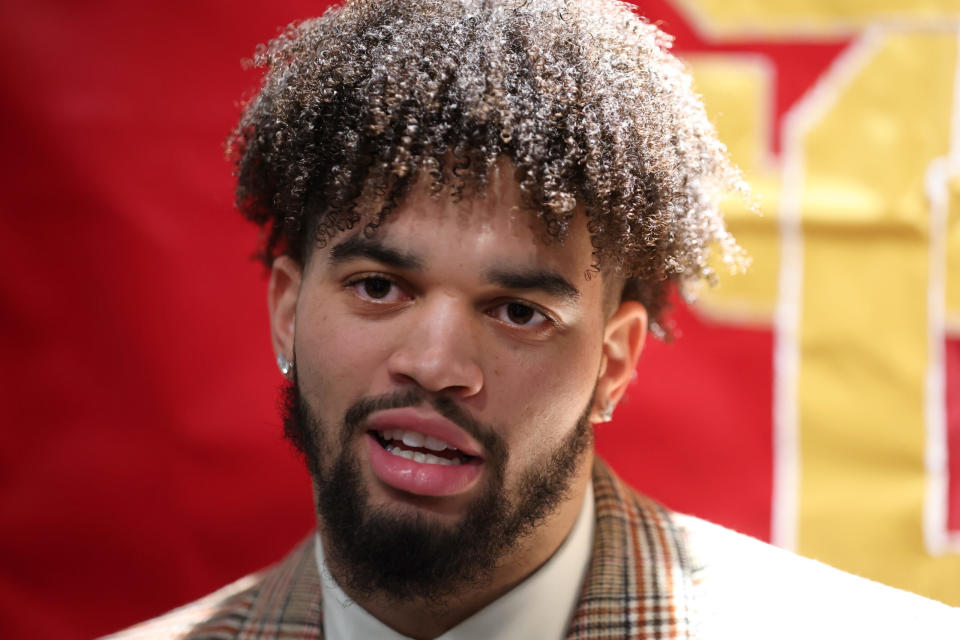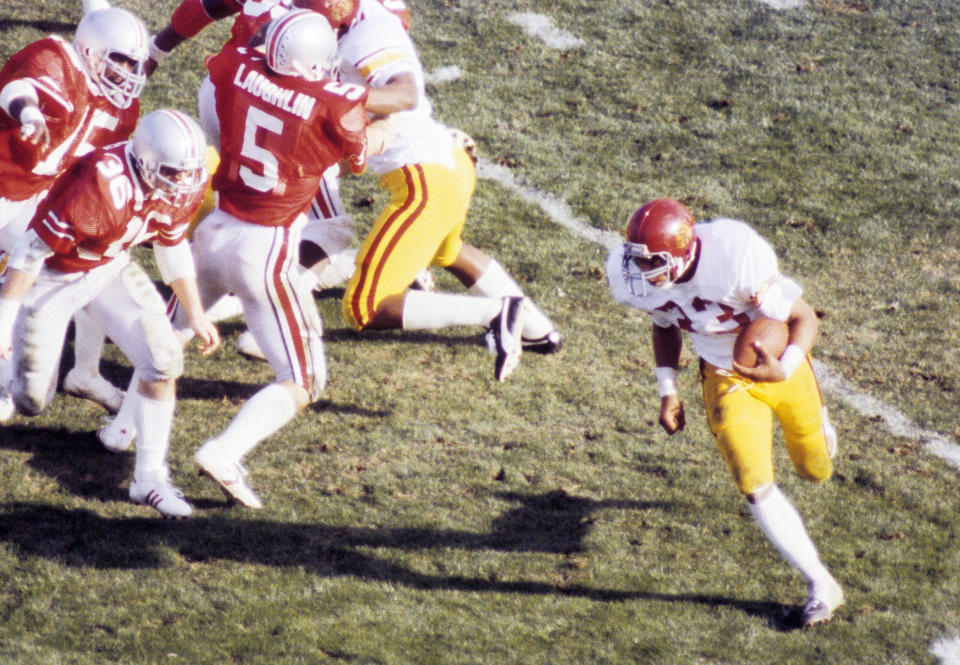The story of USC’s 8 Heisman winners is the story of the Heisman Trophy’s 87-year history

USC is part of a much larger theater of activity and history in college football. In some ways, the Trojans are unique in college football history. This 2022 Heisman Trophy ceremony magnified that fact, and we will explain why as we continue this particular examination of Heisman history.
Yet, for all the ways in which USC is unique — and stands above the crowd — in Heisman history, the Trojans are also an embodiment of the changes which have occurred in college football and the Heisman itself over the years.
There’s plenty to unpack about the evolution of the Heisman in relation to the progression of college football over a larger period of time … and how USC fits within that bigger story:
USC RUNNING BACK HEISMAN WINNERS

Marcus Allen of the USC Trojans, poses with the coveted Heisman Trophy awarded to him at the Downtown Athletic Club in New York, Dec. 6, 1981. Allen, 21, who traversed more football turf than any other player in college football history, was the 47th winner of the Heisman Memorial Trophy. (AP Photo/Ron Frehm)
USC produced four running back Heisman winners in 17 seasons from 1965 through 1981. College football was a running back-centric sport in that era.
USC HEISMAN QBs

NEW YORK – DECEMBER 11: Quarterback Matt Leinart of the University of Southern California Trojans wins the 2004 Heisman Trophy on December 11, 2004 in New York City. (Photo by Chris Trotman/Getty Images)
USC has produced three Heisman QBs this century, in an era when the passing game has been much more front and center in college football.
HEISMAN WINNERS, 1935-1988
Barry Sanders turns 53 today 🎈
The 1988 Heisman Trophy winner made TDs look too easy ⚡️ pic.twitter.com/GEaqeI4JpU
— ESPN College Football (@ESPNCFB) July 16, 2021
When Barry Sanders won the 1988 Heisman, running backs/fullbacks/halfbacks won a 36th Heisman out of 54 trophies awarded. Quarterbacks were not the primary recipients of the award.
FIRST HEISMAN QB: 1938
8 DAYS til Kickoff; here's #8 Davey O'Brien, the 1938 Heisman from TCU: pic.twitter.com/JDTeKrYkeq
— Pick Six Previews (@PickSixPreviews) August 26, 2015
HEISMAN WINNERS, 1935-1961
1947 Heisman Trophy Winner Johnny Lujack is in the house today! pic.twitter.com/pMujFizpHr
— Notre Dame on NBC (@NDonNBC) September 14, 2019
Of the first 27 Heisman winners, only four primarily played quarterback. Some split time at multiple positions, but only four players played the position exclusively.
1960s BEGIN TO CREATE CHANGES

Jan 1,1966; Pasadena, CA, USA: FILE PHOTO; UCLA Bruins quarterback Gary Beban (16) throws the ball against the Michigan State Spartans during the 1966 Rose Bowl where UCLA beat MSU 14-12 at the Rose Bowl Stadium. Mandatory Credit: Long Photography-USA TODAY Sports
In the 1960s, quarterbacks finally began to thrive in Heisman voting. Terry Baker of Oregon State won in 1962. Roger Staubach of Navy won in 1963. John Huarte of Notre Dame won in 1964. Steve Spurrier of Florida won in 1966. Gary Beban of UCLA won in 1967. This was the first decade in which at least half of the Heisman winners were quarterbacks. Yet, this was also the decade in which USC won two Heismans at the running back spot: Mike Garrett in 1965 and O.J. Simpson in 1968.
1972-1983 HEISMANS

University of Southern California running back Charles White gestures to at the Heisman Trophy Monday December 4, 1979 during news conference in Los Angeles. It was annouced that White was selected the 1979 recipient of the sward as college football’s premier player. The trophy shown was awarded to anther USC back, Mike Garrett, in 1964. White will get his trophy in New York later. (AP Photo/Fong)
Though QBs made a push in the 1960s, the Heisman returned to running backs in the 1970s and into the early 1980s. From 1972 through 1983, a period of 12 seasons, no quarterbacks won the award. USC had two more running backs as Heisman winners in this period, with Charles White winning in 1979 and Marcus Allen winning in 1981.
1980s: STILL NO FOOTHOLD FOR QBs

Jan 1, 1980; Pasadena, CA, USA: FILE PHOTO; Southern California Trojans running back Marcus Allen (33) in action against the Ohio State Buckeyes during the 1980 Rose Bowl game where USC defeated OSU 17-16 at the Rose Bowl Stadium. Mandatory Credit: Long Photography-USA TODAY Sports
In the 1980s, quarterbacks stopped the 12-year drought at the Heisman which began in 1972, but over the full decade, the position still had not wrested control of the award from running backs. Doug Flutie, Vinny Testaverde, and Andre Ware won the award in this decade, but overall, running backs still won six Heismans in this decade. Quarterbacks won three, and receiver Tim Brown won the 1987 Heisman at Notre Dame.
THE SPURRIER EFFECT

2 Jan 1997: Florida Gators head coach Steve Spurrier celebrates after the Nokia Sugar Bowl against the Floirda State Seminoles at the Superdome in New Orleans, Louisiana. Florida won the game, 52-20. Mandatory Credit: Doug Pensinger /Allsport
Steve Spurrier and Bobby Bowden brought freewheeling passing offenses to the center of college football in the 1990s. They both coached Heisman QBs: Danny Wuerffel for Florida in 1996, Charlie Ward for Bowden at Florida State in 1993. Modernized offenses with more emphasis on the passing game began to change the sport in favor of quarterbacks. While QBs didn’t win a majority of the 10 Heismans handed out in the 1990s, they did win as many Heismans as running backs: Each group won four times. Wide receivers won once, and defensive back Charles Woodson won as well.
2000s: CHANGE SWEEPS THROUGH COLLEGE FOOTBALL

Jan 1, 2004; Pasadena, CA, USA: FILE PHOTO; Southern California Trojans quarterback Matt Leinart (11) in action against the Michigan Wolverines during the 2004 Rose Bowl at the Rose Bowl. The Trojans defeated the Wolverines 28-14. Mandatory Credit: Richard Mackson-USA TODAY Network
This was the decade when the changes seen in the 1990s led to changes in Heisman winners. This is when quarterbacks took over.
In the 2000s, quarterbacks won eight of 10 Heismans. The only exceptions were Reggie Bush in 2005 and Mark Ingram in 2009.
Two USC quarterbacks, Carson Palmer and Matt Leinart, were part of that parade of quarterbacks at the Heisman victory podium.
The game changed, and USC was part of it.
In the early 2000s, it was clear: College football had become a quarterback-centric sport, leaving behind the early 1980s and Student Body Right under USC and John Robinson, with Marcus Allen winning yet another Heisman Trophy for the Trojans as a running back.
FUN FACT

Dec 10, 2022; New York City, New York, USA; USA Trojans quarterback Caleb Williams reacts after winning the Heisman Award at The Lincoln Center. Mandatory Credit: Todd Van Emst/Heisman Trust Pool Photo via USA TODAY Sports
With Caleb Williams winning the 2022 Heisman, 19 of the last 23 Heisman winners have been quarterbacks. The four exceptions: Bush in 2005, Ingram in 2009, Derrick Henry in 2015, and DeVonta Smith in 2020.
USC loaded up on Heisman running backs from 1965-1981. Now it is loading up on Heisman QBs, with three in the past 21 seasons precisely when QBs are taking over the award.
PIVOT POINT: HOW USC IS UNIQUE IN THE HEISMAN STORY
We have talked about how USC embodies the changes in college football over time. Let’s briefly note how the Trojans stand apart from and above the crowd in Heisman history:
LINCOLN RILEY
In the past 6 seasons, Lincoln Riley has coached four players who have finished in the top two of the #Heisman voting.
Jalen Hurts was the 2019 runner-up. #USC #Sooners
— USC Trojans Wire (@TrojansWire) December 11, 2022
USC IS THE ONLY SCHOOL WITH TWO COACHES OF 3 HEISMAN WINNERS
Lincoln Riley joins Pete Carroll as a coach of 3 #Heisman Trophy winners.
— USC Trojans Wire (@TrojansWire) December 11, 2022
USC COACHING FRATERNITY
Four #USC coaches have coached multiple #Heisman winners, more than any other school:
Carroll
Riley* (at different schools)
John McKay
John Robinson— USC Trojans Wire (@TrojansWire) December 11, 2022
HISTORIC
Lincoln Riley becomes just the 2nd coach in the 153-year history of college football to coach #Heisman winners at multiple schools (Oklahoma, #USC).
Tommy Prothro (Terry Baker of Oregon State in 1962, Gary Beban of UCLA in 1967) is the other.
— USC Trojans Wire (@TrojansWire) December 11, 2022
DESTINED FOR GREATNESS
Lincoln Riley has coached 3 #Heisman Trophy winners.
He is not yet 40 years old.
— USC Trojans Wire (@TrojansWire) December 11, 2022
THE LINCOLN EFFECT
#Heisman Trophy winners over the past 6 seasons:
3 from the SEC
2 from Oklahoma
2 from Alabama
1 from #USC
1 from LSU3 coached by Lincoln Riley
— USC Trojans Wire (@TrojansWire) December 11, 2022

